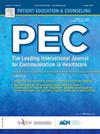智利医院的患者体验和满意度:加强以人为本的护理的见解
IF 3.1
2区 医学
Q2 PUBLIC, ENVIRONMENTAL & OCCUPATIONAL HEALTH
引用次数: 0
摘要
目的本研究探讨了智利医院患者满意度与患者体验的各个领域之间的关系,旨在为加强以人为本的护理提供证据。方法:采用文化适应调查,收集两家高复杂性医院758例近期出院患者的数据。采用广义有序logit模型分析不同体验维度对整体满意度的影响。结果8个体验变量对满意度有显著影响:房间清洁度、药物副作用信息、主治医生的明确沟通、向家属提供的反馈、与临床工作人员的双向沟通、患者参与治疗决策、医疗问题的解决以及信息冲突的消除。值得注意的是,与患者和家属的有效沟通成为满意度的关键决定因素。亚组分析揭示了基于年龄和教育水平的重要差异。例如,26岁或26岁以下的患者比老年人更不重视沟通和信息,这可能是由于围绕医疗决策的文化规范。受教育程度较低的患者更重视参与护理决策,但受所提供信息的影响较小。结论这些结果突出了患者满意度的多维性,加强了医院采取差异化策略的必要性。实践启示:有效的沟通、患者参与和对人口统计学特征的关注对于提高满意度和实现更多以人为本的医疗保健至关重要。本文章由计算机程序翻译,如有差异,请以英文原文为准。
Patient experience and satisfaction in Chilean hospitals: Insights for enhancing person-centered care
Objective
This study examines the relationship between patient satisfaction and various domains of patient experience in Chilean hospitals, aiming to provide evidence to enhance person-centered care. Methods: Using a culturally adapted survey, data were collected from 758 recently discharged patients from two high-complexity hospitals. A generalized ordered logit model was applied to analyze the impact of different experience dimensions on overall satisfaction.
Results
The findings show that eight experience variables significantly influence satisfaction: room cleanliness, information about medication side effects, clear communication from treating doctors, feedback provided to family members, two-way communication with clinical staff, patient involvement in treatment decisions, resolution of the medical issue, and the absence of conflicting information. Notably, effective communication with patients and families emerged as a key determinant of satisfaction.
Subgroup analyses revealed important variations based on age and education level. For example, patients aged 26 or younger placed less value on communication and information than older groups, possibly due to cultural norms around medical decision-making. Patients with lower education levels valued participation in care decisions more, but were less influenced by the information provided.
Conclusions
These results highlight the multidimensional nature of patient satisfaction and reinforce the need for differentiated strategies in hospitals. Practice Implications: Effective communication, patient engagement, and attention to demographic characteristics are essential to improving satisfaction and achieving more person-centered healthcare.
求助全文
通过发布文献求助,成功后即可免费获取论文全文。
去求助
来源期刊

Patient Education and Counseling
医学-公共卫生、环境卫生与职业卫生
CiteScore
5.60
自引率
11.40%
发文量
384
审稿时长
46 days
期刊介绍:
Patient Education and Counseling is an interdisciplinary, international journal for patient education and health promotion researchers, managers and clinicians. The journal seeks to explore and elucidate the educational, counseling and communication models in health care. Its aim is to provide a forum for fundamental as well as applied research, and to promote the study of organizational issues involved with the delivery of patient education, counseling, health promotion services and training models in improving communication between providers and patients.
 求助内容:
求助内容: 应助结果提醒方式:
应助结果提醒方式:


